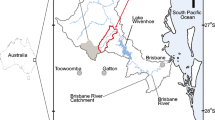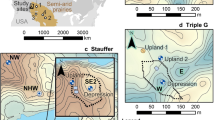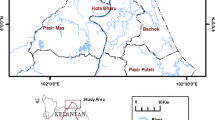Abstract
There is unanimity in the literature that chloride mass flux crossing the piezometric surface requires a steady-state for the saturated or unsaturated version of the conventional chloride mass balance (CMB) method to apply. Data indicate that chloride concentration in point recharge fluxes crossing the piezometric surface can remain at or near surface runoff chloride concentrations, rather than finding equilibrium with groundwater chloride. Preferential groundwater flows were observed through an interconnected network of highly permeable zones with groundwater mixing along flow paths. Measurements of salinity and chloride indicated that fresher water pockets exist at point recharge locations. A stable and measurable fresh water plume develops only when a large quantity of surface water enters the aquifer as a point recharge. In such circumstances, assumptions and boundary conditions of the conventional CMB method are not met, and the method requires modification to include both point and diffuse recharge mechanisms. This paper describes a generalised CMB that is applicable to groundwater basins with point recharge. In three case studies, point recharge flux is estimated to contribute 63, 85, and 98 % of total recharge. However, long-term average annual point recharge volumes are much smaller than the aquifer storage, at 1.5, 1.95, and 0.75 % and distributed across the basins at discrete locations. In the study basins, conventional CMB-estimated recharges are 46, 20, and 11 % of the recharge estimated using the generalised CMB, indicating the importance of accommodating point recharge into the CMB method. The generalised CMB method provides an alternative long-term net recharge estimation method for groundwater basins characterised by both point and diffuse recharge.





Similar content being viewed by others
References
Allison GB (1988) A review of some physical, chemical and isotopic techniques available for estimating groundwater recharge. In: Simmers I (ed) Estimation of natural groundwater recharge. D. Reidel Publishing Co., Dardrecht, pp 49–72
Allison GB, Harvey PD (1983) Freshwater lakes. In: Tyler MJ, Twidale CRT, Ling JK, Holmes JW (eds) Natural History of the South East. Royal Society of South Australia, South Australia, pp 61–74
Allison GB, Hughes MW (1978) The use of environmental chloride and tritium to estimate total recharge to an unconfined aquifer. Aust J Soil Res 16:181–195
Amoah JK, Amatiya DM, Nnaji S (2012) Quantifying watershed surface depression storage: determination and application in a hydrologic model. Hydrol Processes 27(17):2401–2413. doi:10.1002/hyp.9364
Bakalowicz M (2005) Karst groundwater: a challenge for new resources. Hydrogeol J 13:148–160. doi:10.1007/s10040-004-0402-9
Cook PG, Edmunds WM, Gaye CB (1992) Estimating paleo-recharge and paleo-climate from unsaturated zone profiles. Water Resour Res 28:2721–2731
Eco Environmental (2013) Salinity sonde, Environmental monitoring and sampling equipment. http://ecoenvironmental.com.au (accessed 08 October 2013)
Eriksson E, Khunakasem V (1969) Chloride concentration in groundwater, recharge rate and rate of deposition of chloride in the Israel Coastal Plain. J Hydrol 7:178–197
Evans SL (1997) Estimating long-term recharge in unconfined carbonate aquifers using conventional and environmental isotope techniques-Eyre Peninsula, South Australia, Masters Thesis, Flinders University of South Australia, unpublished
Eyre Region Water Resources Planning Committee (2000) Water allocation plan southern basins prescribed wells area. Government of South Australia, through Department of Water Resources, South Australia
Gee GW, Zhang ZF, Tyler SW, Albright WH, Singleton MJ (2005) Chloride mass balance: cautions in predicting increased recharge rates. Vadoze Zone J 4:72–78
Ginn TR, Murphy EM (1996) Generalized chloride mass balance: Forward and inverse solutions for one dimensional tracer convection under transient flux, Pacific Northwest Laboratory, Prepared for the US. Department of Energy under contract DE-AC06-76RLO 1830
Guan H, Love AJ, Simmons CT, Hutson J, Ding Z (2010) Catchment conceptualisation for examining applicability of chloride mass balance method in an area with historical forest clearance. Hydrol Earth Syst Sci 14:1233–1245. doi:10.5194/hess-14-1233-2010
Gunn J (1983) Point-recharge of limestone aquifers—a model from New Zealand karst. J Hydrol 61:19–29
Harrington N, Zulfic D, Wohling D (2006) Uley basin groundwater modelling project, Vol. 1, Project overview and conceptual model development, DWLBC Report 2006/01, Government of South Australia
Herczeg AL, Leaney FW, Stadter MF, Allan GL, Fifield LK (1997) Chemical and isotope indicators of point-source recharge to a karst aquifer, South Australia. J Hydrol 192:271–299
Hutson JL (2003) LEACHM—A process-based model of water and solute movement, transformations, plant uptake and chemical reactions in the unsaturated zone, version 4. Research Series No. R03-1, Department of Crop and Soil Sciences, Cornell University, Ithaca, New York
Hutton JT (1976) Chloride in rainwater in relation to distance from the ocean. Search 7:207–208
Lawson J (2013) Water quality and movement of the unconfined and confined aquifers in the capture zone of the Blue Lake, Mount Gambier, South Australia and implications for their management, Masters thesis, University of South Australia, unpublished
Leaney FW, Herczeg AL (1995) Regional recharge to a karst aquifer estimated from chemical and isotopic composition of diffuse and localised recharge, South Australia. J Hydrol 164:363–387
Lerch RN, Wicks CM, Moss PL (2005) Hydrologic characterization of two karst recharge areas in Boone County, Missouri. J Cave Karst Studies 67(3):158–173
Linacre ET (1977) A simple formula for estimating evaporation rates in various climates, using temperature data alone. Agric Meteorol 18:409–424
MacKenzie G (2013) Hydrochemical data of the Tatiara catchment, Department of Environment, Water and Natural Resources, Naracoorte, unpublished
Martin JB, Dean RW (2001) Exchange of water between conduits and matrix in the Floridan aquifer. Chem Geol 179:145–165
Martin JB, Screaton EJ (2001) Exchange of matrix and conduit water with examples from the Floridan aquifer. In: Kuniansky (Ed), US Geological Survey Karst Interest Group Proceedings, Water Resources Investigation Report 01-4011, 99.38–44
McDonald MG, Harbough BR (1988) A modular three-dimensional finite difference groundwater flow model, Techniques of Water Resources Investigations of the U.S. Geological Survey, Book 6, Geological Survey Open File Report 91-536, USGS
MUSIC (2009) Model for urban storm water improvement conceptualisation (MUSIC). MUSIC Development Team, eWaterCRC, Australia
Mustafa S, Lawson JS (2002) Review of Tertiary aquifer properties, Gambier Limestone, Lower South-East, South Australia, Department of Water, Land and Biodiversity Conservation, Report DWLBC 2002/24, unpublished
Nguyen K (2013) Estimating the annual storm water yield in the Blue Lake capture zone, South Australia, M. Eng thesis, University of South Australia, unpublished
Nyagawambo NL (2006) Groundwater recharge estimation and water resources assessment in a crystalline basement aquifer, PhD thesis, Delft University of Technology, Delft, The Netherlands, A. A. Balkema Publishers, ISBN 0 415 41692 2
Ordens CM, Werner AD, Post VEA, Hutson JL, Simmons CT, Irvine BM (2012) Groundwater recharge to a sedimentary aquifer in the topographically closed Uley South basin, South Australia. Hydrogeol J 20:61–72. doi:10.007/s10040-011-0794-2
Scanlon BR, Healy RW, Cook PG (2002) Choosing appropriate techniques for quantifying groundwater recharge. Hydrogeol J 10:18–39. doi:10.1007/s10040-001-0176-2
Somaratne N (2011) Salinity profiling and chloride measurement in storm water discharge drainage wells in Blue Lake capture zone, Internal Project Briefing Report, South Australian Water Corporation, South Australia, unpublished
Somaratne N (2012) Pitfalls in the application of the chloride mass balance method to groundwater basins dominated by point recharge, SA Water Hydrogeological Research Report, SA Water 2012/1, unpublished
Somaratne N (2014) Characteristics of point recharge in karst aquifers. Water 6:2782–2807. doi:10.3390/w6092782
Somaratne N, Frizenschaf J (2013) Geological control upon groundwater flow and major ion chemistry with influence on basin management in a coastal aquifer, South Australia, J Water Res Prot, 5, 1170–1177. http://dx.doi.org/10.4236/jwarp.2013.512124
Somaratne N, Smettem K, Frizenschaf J (2014a) Three criteria reliability analyses for groundwater recharge estimations. Environ Earth Sci. doi:10.1007/s12665-014-3121-0
Somaratne N, Lawson J, Ashman G, Nguyen K (2014b) Recharge to Blue Lake and strategies for water security planning, Mount Gambier, South Australia, J Water Res Prot, 6, 772–783, doi:10.4236/jwrp.2014.68073
Stadter F, Love AJ (1987) Tatiara proclaimed region groundwater assessment, South Australian Department of Mines and Energy, Report Book 87/87, unpublished
Subyani A, Sen Z (2006) Refined chloride mass-balance method and its application in Saudi Arabia. Hydrol Processes 20:4373–4380. doi:10.1002/hyp.6172
Taylor CJ, Greene EA (2001) Quantitative approaches in characterizing karst aquifers. US Geol Surv Karst Interest Group Proc, Water Resour Invest Rep 01–4011:164–166
Tihansky AB (1999) Sinkholes, West Central Florida. In: Land Subsidence in the United States: US Geological Survey Circular, vol 1182, pp 121–140
Turner JV, Allison GB, Holmes, JW (1983) Environmental isotope methods for determination of Lake-Groundwater relation: Application to determine the effect of Man’s Activities. International Conference on Groundwater and Man, Sydney, Australia
Vail J (2011) Groundwater sampling, US. Environmental Protection Agency, Science and Ecosystem Support Division, Athens, Georgia, SESDRPROC-301-R2
Walker GR, Jolly ID, Cook PG (1991) A new chloride leaching approach to the estimation of diffuse recharge following a change in landuse. J Hydrol 128:49–67
Ward JD, Hutson J, Howe B, Fildes S, Werner AD, Ewenz C (2009) A modelling framework for the assessment of recharge processes and climate change, Report developed through the Eyre Peninsula Groundwater allocation and Planning Project, Eyre Peninsula Natural Resources Management Board, Government of South Australia
Waterhouse JD (1977) The hydrogeology of the Mount Gambier area, Report of Investigations 48, Geological Survey of South Australia, p 61
Watermark Numerical Computing (2004) PEST-Model independent parameter estimation, User’s manual: 5th edition, available at: http://www2.epa.gov/sites/production/files/documents/PESTMAN.PDF (accessed 9 January 2014)
Werner AD (2010) A groundwater model of Uley South Basin, South Australia, Flinders University of South Australia, unpublished
White WB (2003) Conceptual model for karstic aquifers, Speleogenesis and Evolution of Karst Aquifers, The Virtual Scientific Journal, 1(1), p 2, http://www.speleogenesis.info (accessed 15 January 2013)
Williams JR (1991) Chapter 18—Runoff and water erosion. In: Hanks J, Ritchie JT (Eds) Modelling Plant and Soil Systems, Agronomy Monograph 31, American Society of Agronomy, Madison, Wisconsin, chap. 18, pp 439–455
Wood WW (1999) Use and misuse of the chloride mass balance method in estimating groundwater recharge, Technical Commentary, Groundwater, vol 37, pp 2–3
Wood WW, Rainwater KR, Thompson DB (1997) Quantifying macropore recharge: examples from a semi-arid area. Gr Water 35:1097–1106
Zhu C, Winterle JR, Love EI (2003) Late Pleistocene and Holocene groundwater recharge from the chloride mass balance method and chlorine-36 data. Water Resour Res 39(7):1182. doi:10.1029/2003WR001987
Acknowledgments
The anonymous reviewer is thanked for his useful comments. Much help was received from the following, who are gratefully acknowledged: Prof. Keith Smettem for contribution to an earlier version of the manuscript and reviews, Prof. Wolfgang Kinzelbach for reviewing the generalised CMB methodology, Glyn Ashman and Jacqueline Frizenschaf for review of the manuscript, Jeff Lawson for assistance with groundwater sampling in Mount Gambier, George MacKenzie for providing Scowns sinkhole and Tatiara Creek flow data.
Author information
Authors and Affiliations
Corresponding author
Rights and permissions
About this article
Cite this article
Somaratne, N. Pitfalls in application of the conventional chloride mass balance (CMB) in karst aquifers and use of the generalised CMB method. Environ Earth Sci 74, 337–349 (2015). https://doi.org/10.1007/s12665-015-4038-y
Received:
Accepted:
Published:
Issue Date:
DOI: https://doi.org/10.1007/s12665-015-4038-y




